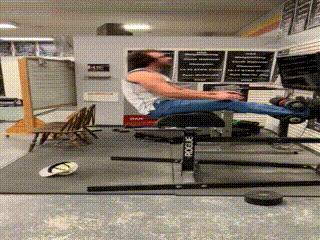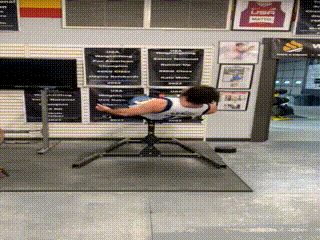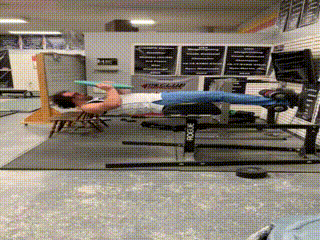GHD Sit Ups
The GHD Sit Up, Variations, And Other Core Exercises For Dynamic Trunk Control
A strong core is a big contributor to athletic performance. Athletes with powerful core muscles possess the ability to stay firm guarding a defender in the post, to not get bodied in a scrum, and maintain spine stability when initiating contact in football.
The core is a collective of muscles. Don’t think of the core as only the abdominal muscles, but think of it as the totality of the muscles around the belly and lower back, the area that the Garage Strength crew calls the trunk and is trained often in our strength training app designed for athletes, Peak Strength. The trunk includes a wide breadth of muscles such as the obliques (external and internal), the serratus posterior inferior, the erector spinae, the multifidus, and even the fascia coming from the latissimus dorsi, the thoracolumbar fascia, and the quadratus lumborum (commonly simplified as the QL).
Training the core/trunk muscles is necessary for athletes. Rotation, anti-rotation, stabilization, remaining upright, bending forward, backward, and side to side, and improving the capability to transfer power, impulse, and explosiveness from the lower body up through the torso and upper limbs is a must.
There is one exercise, the GHD sit up, that is a classic in the realm of CrossFit, and does a phenomenal job of giving the abdominal muscles an aesthetically pleasing look for rippling six pack abs. The GHD sit up is also incredibly difficult and sneaky in the muscles it asks for athletes to recruit.
GHD Sit Up
The GHD sit up is performed on a glute ham developer machine. You actually use the machine in an incorrect manner to perform the sit up.
The machine is called the glute ham developer for a reason, it is designed to develop your glutes and hamstrings. In its correct usage, you get into the GHD machine, lock your feet in, and your face is staring at the ground. From there you have a lot of options of how to use the machine to develop your glutes, hamstrings, and even your lower back muscles (a big part of the core, and some exercises we will discuss later on).
For the GHD sit up, you get your feet locked in, but instead of looking toward the floor you are now in a position where you are looking at the ceiling, Feel free to count the lights if the spirit moves you.

To perform the GHD sit up looks easy. It’s not.
I remember my first time doing GHD sit ups. I was in a CrossFit box and had seen elite CrossFit athletes performing this weird sit up variation on a machine that sat in the back corner of the gym. I had never seen any member of the box’s community use the GHD machine.
Equipped with the knowledge of what the movement looked like; I headed over to the machine. First, I stepped my foot on the metal beam from the area to lock in the feet to the padded area where the hips and butt rest. Balanced on the beam, I gave myself more support by grabbing the middle of the place where my feet would lock in to stay balanced. I then shifted my hips and butt onto the pad, continuing to hold the part of the machine where my feet would lock in. I then slid my right foot through the padded foot lock and followed that up with my left foot.
With my feet locked in, I got my butt in a comfortable position on the semi-circle padded area. From what I had seen on a video of elite CrossFit athletes doing the movement, all I needed to do was reach down, touch the floor with both hands, use my abdominal muscles to come back up, touch my feet, rinse and repeat.
I had no fear. I knew my feet were locked in so I started my descent backward, looking at the ceiling. As I inched further and further down, I thought, “Where is the floor?” Because I didn’t fling myself back. It was my first time, so I was cautious. The back bend that occurs can be pretty extreme for some athletes.
Taking it slow, my hands eventually made contact with the ground. Upon making contact, I flung my arms forward to give me a helpful boost and sat up. And boy did I feel it! My abdominals were blazing. The stretch, the range of motion, the use of SO MANY muscles.
I was in love.

I went ahead and did 6x15 for a total of 90 reps.
And did I pay for that!
My abs were sore to the touch the next day. And the day after that, and the day after that! Getting off the couch was a herculean effort, and an unannounced sneeze was a fit of pain. Every lift hurt even more.
But eventually the DOMS subsided, and my body adapted. The next time I did the movement the muscle soreness lessened and my new favorite core exercise for rippling muscles no longer ignited near a week’s worth of delicate, thoughtful movement to get out of bed, off the couch, or picking up groceries.
As my experience with the GHD sit up matured, I learned some neat tricks and some hard lessons. One hard lesson is that as much as the GHD sit up is an ab exercise that benefits the core greatly, it is also an anterior sequence exercise.
The anterior sequence in the flipside of the posterior chain. So where the posterior chain is the hamstrings, glutes, lower and upper back, the anterior sequence is the chest, abdominals, and quads.
With the GHD sit up, the quads get worked and are a big driver of being able to sit up. It comes from the stretch of the movement being so large. The hip flexors, which include the psoas major and iliacus muscles connect the quads to the abdomen. And boy, oh, boy do these muscles catch the brunt of the burn during executing the exercise for high reps.
I also learned a cool trick. Where I immediately understood the benefit of using your arms to help with momentum of the sit up, making it faster, quicker, and more dynamic, it took me a while to grasp this other more important trick.
Flexing the quads, or more specifically, pushing your knees to the ground. It works like a catapult of sorts. You simply flex your quad muscles and because the anterior sequence plays such a large role in the GHD sit up, you can generate more power and force to sit up faster and with ease. So, when my abs are dying and my hip flexors need a break, I will get that extra umph from the quads.
GHD Sit UP Variations
Like any exercise, doing the same thing over and over and over again becomes a slag. You, probably like me, seek out some variation. The GHD sit up does not disappoint in this regard. There are numerous variations of the movement that can be completed, but I’m going to give you three.
Med Ball Weighted GHD Sit Up
The weighted GHD sit up is tough. It really demands a higher degree of engagement from the arms. You can do a GHD sit up with a bodyweight vest or a plate being held against your chest, but the ultimate way to do a GHD sit up weighted is by holding a med ball or wall ball.
Nothing changes about how you perform the GHD sit up weighted with a med ball. The only difference is you now have a med ball grasped firmly between your hands. Instead of reaching back at your end range of motion to touch the floor with your hands, you are now reaching back to touch the med ball to the floor.

Remember how I talked about using your arms to assist completing the GHD sit up? Well with the med ball it is a must. Good luck doing the movement as strictly as possible, lol. It can be done–I’ve done it, but it isn’t fun or necessary. The dynamic motion with the med ball is more attuned to moving in an athletic manner.
GHD Side Bends
I had workout partners who used to do this version of the GHD sit up and call them squirmies. I think that word is funny and an accurate description of what you look like doing the GHD side bends.
The tough part of this variation is you have to hold an isometric position. Essentially, you want your body parallel to the ground; it’s brutal.
Your body parallel to the ground, holding the isometric position, you can then perform the GHD side bend.
With your arms at your side, you then reach to touch the padded area your butt is perched on. Your right arm reaches to the right side as you bend your torso that way. You then alternate to the left side, reach with your left, and bend your torso that way.

The movement is rather rapid. You alternate side to side reaching. And of course, you look like you're squirming, lol.
This one is good for the obliques, but that isometric hold is no joke. You will want to do this exercise for high reps or for a designated period of time because you are holding that static horizontal position simultaneously.
GHD Plate Pass
This GHD sit up variation is another one where you hold an isometric position in which the body is parallel to the ground. Also, this movement is absolutely brutal. It is like a death metal riff that pummels the brain into a pulp of rot.
To do the GHD plate pass, get into the GHD machine the same way you would to perform a sit up. But you need to be holding a plate. The plate does not need to be heavy, especially if this is your initial attempt at the movement.
Get your body into the isometric position with the trunk being parallel to the floor. With the plate firmly gripped in your hands, you now extend your arms over your head. The aim is to get your biceps to your ears, your arms completely locked out and stretched overhead, and then bring the plate back to the torso area.

Be warned, when you reach the plate overhead, you change the movement arm and the stress on the core spikes. You need to be rigid and engaged through the entirety of the abdominals performing this exercise.
Think of the movement as performing the ab roller suspended in air.
Which reminds me! If you want a dummy abdominal pump, super set the GHD plate pass with the ab roller and you can accelerate the acquisition of six pack abs.
Core & Trunk Exercises
Athletes need to use their core and trunk in all things sport. The GHD sit up, and its variations, are great for developing musculature throughout the abdominals. But as athletes, we also have to take into the totality of the trunk. We can’t just train the anterior part of the body using the GHD, but also have to train the posterior as well. That means we have to use the GHD machine as intended and do some work with the trunk looking at the floor and not the ceiling.
Back Extensions
Back extensions are a tried and true exercise that develops the lower back, while also working the glutes and hamstrings.
To perform the back extension, think of doing a good morning, except you are strapped into a GHD machine. Feet secured in the GHD machine, eyes looking at the ground, you bend at the hips and keep the legs stiff and straight. Lowered as far as you can go, you then engage through the lower back, glutes, and hamstrings and extend the torso back up.
You can advance this exercise in a few ways. You can do it with a band to add a slight load at the hardest part of the movement. You can hold a dumbbell or plate to add intensity. Or you can really take it to the next level of strength and put a loaded barbell on your upper back and do work.

Isometric Holds
Exactly as the title implies, you do an isometric hold. Face it, the core and trunk’s main purpose is to keep the torso upright. Putting the body at a disadvantaged position and holding isometrically helps develop that athletic strength.
Now you can up the difficulty by doing a few things. You can begin by increasing the length of the hold. Instead of holding for thirty seconds, you can hold for a full minute.
A second way you can increase the difficulty of the isometric hold is by adding weight. You can start by adding weight by holding it in your hands. As you get stronger, you can gradually increase the weight you hold.
The other way you can increase the difficulty is by putting weight on your back. You can use a barbell, but you are probably better off emulating the Chinese weightlifting team and stacking change plates on your back relative to your strength and capabilities.

Rotating Back Extension
Not all trunk and core work is bending, flexing, or holding isometrics. For athletes, a lot of core work needs to come from rotational movements. The core and trunk is not a static portion of the body, but a portion of the body that needs to allow for fluidity and flexibility in movement. Twisting and turning, particularly in open skilled sports like soccer, football, lacrosse, field hockey, baseball/softball, and basketball is a must.
To perform the rotating back extension, get yourself into the GHD machine with your eyes looking at the ground. Bend at the hips like you would for a normal back extension and lower the torso. Here is where things change up–as you accelerate your body back up toward the ceiling, you want to twist the torso so that the side you are twisting towards the elbow is pointing at the ceiling.

You can alternate side to side, but I recommend doing all the reps to one side and then doing all the reps to the other side.
To make this derivative of the back extension more challenging, you can use a band. There is a trick to how you wrap the band. You want to first anchor the band. Then you want to feed the band under your armpit, over your back, and then into the opposite side's hand. The hand holding the band is the side you will rotate to.
Dynamic Trunk Control
Being that this is a Garage Strength blog talking about core work, I’d be remiss to not mention dynamic trunk control (DTC).
Dynamic trunk control is an athlete’s ability to coordinate power throughout the body through the trunk. It is also the ability to hold stability and not get bodied by an opponent, as well as the ability to hold positions throughout an athletic movement–rotating, twisting, bending, or flexing.
Dynamic trunk control is how an athlete quiets the ‘noise’ when making an agile juke to avoid an opponent, collects the body in a deceleration as they step back to splash a jumper, or brace up to bring the ruckus with that blast double.
All of that to say: dynamic trunk control is necessary for athleticism.
Sample Lower Body Power Workout (Core Focused)


The Bottom Line
The GHD sit up is an awesome movement to develop the abdominal musculature. It low key engages the anterior sequence into coordinating ample musculature and forces the muscles through a large range of motion.
Where the movement has its detractors, it also has strong proponents in the world of fitness. Rightfully so! The GHD sit up, and its variations, are challenging movements that build core strength and create unrivaled abdominal endurance.
So, if you’re an athlete looking to train using the GHD sit up, or any core and trunk exercise to develop dynamic trunk control for that matter, head over to peakstrength.app and download Peak Strength our strength training app developed with athletes in mind so you can reap the benefits of the GHD sit ups and over 700+ exercises.
Later.


EARL KUNKEL
3x World Champion Co-Author of the Year
King of the PA Press
Blog Topics

Yo, It's Dane
Welcome to the Garage Strength Blog, where it is my goal to provide you with the experience and knowledge I've gained in the strength and conditioning world over many years of learning from both successes and failures. I train elite-level athletes in a multitude of sports from the high school to professional levels, already producing 5 Olympics and 30+ National Champions. If you want to be the next champion I train, check out my strength programs below!
Start Training With Me

Join for free educational videos EVERY WEEK on strength coaching and athletic performance

